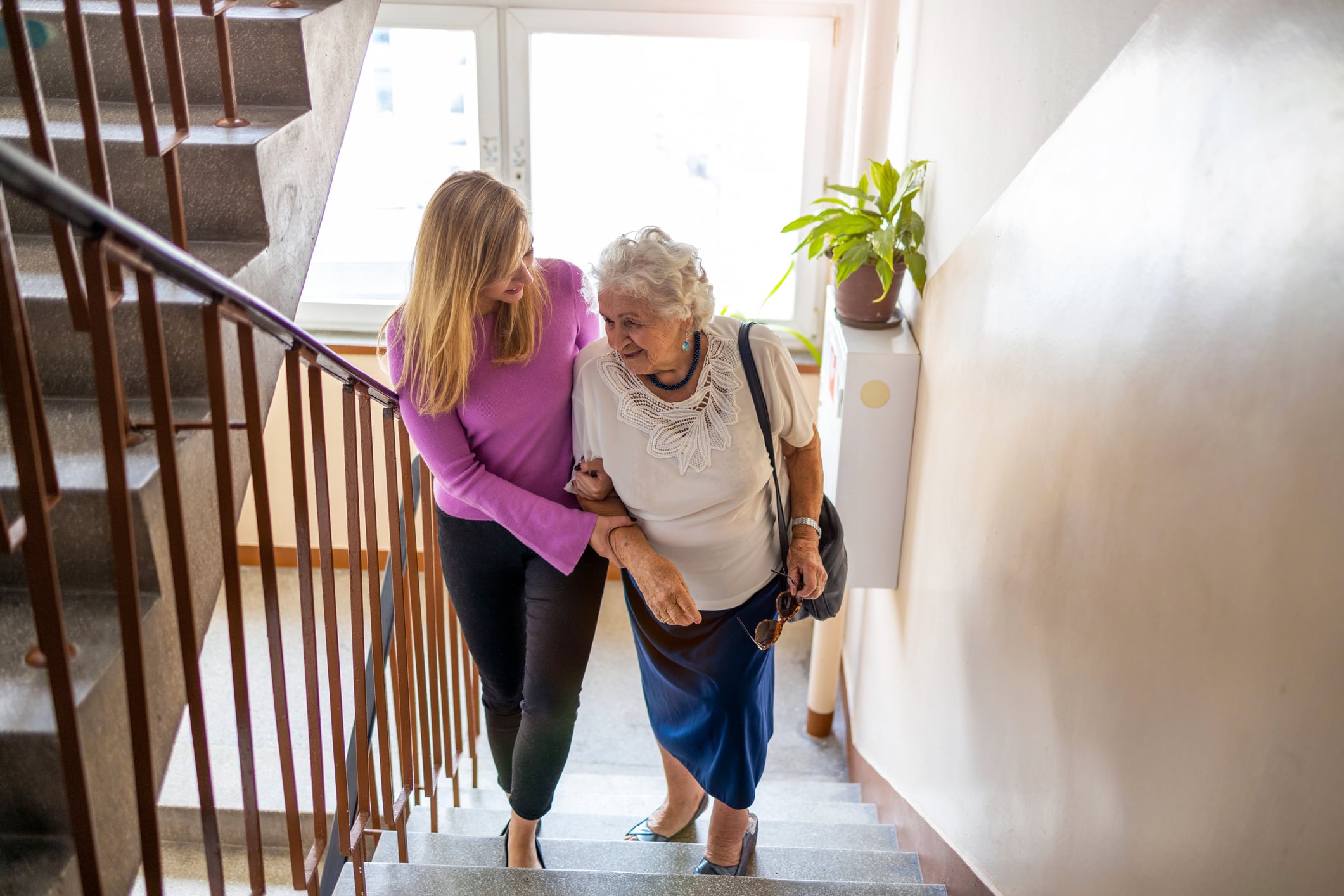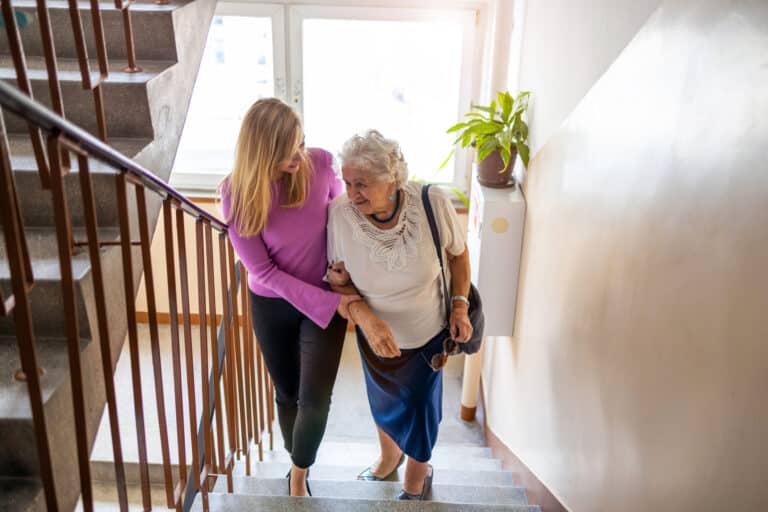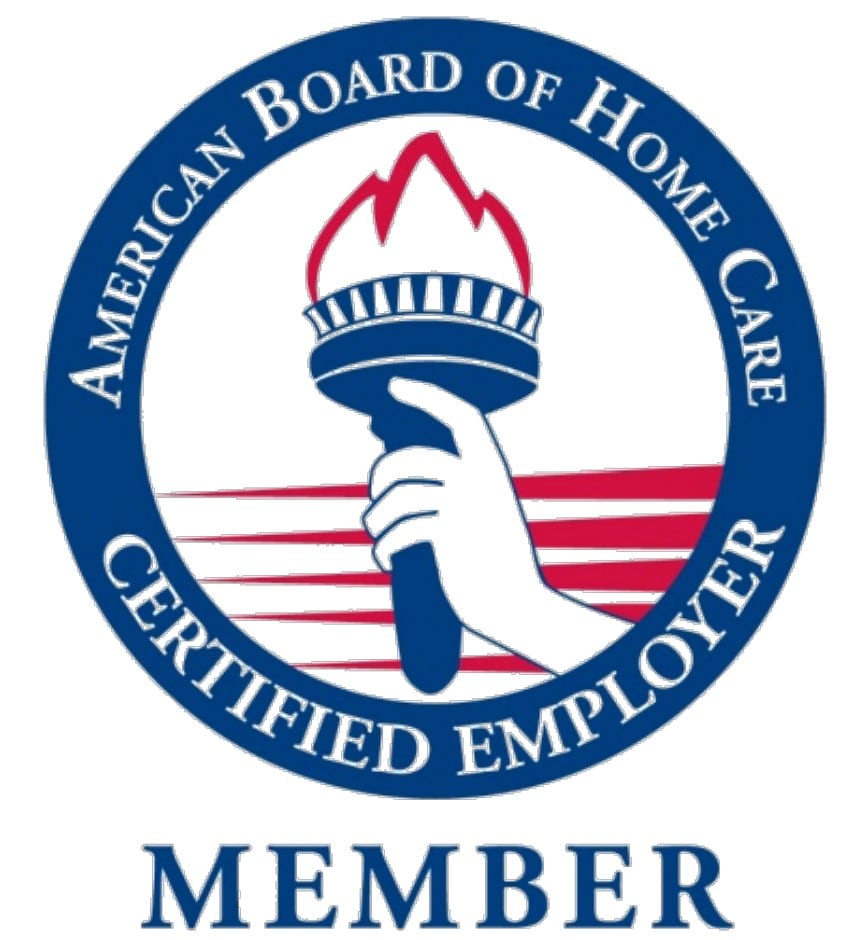
Most caregivers don’t worry about their own health- they’re solely focused on the person for whom they’re caring. But those who provide care to an older or disabled loved one tend to live with high chronic stress and skimp on self-care — factors that raise the risk for negative emotional and physical health outcomes.

Caregiving and COVID-19
COVID-19 has exacerbated the stress that comes with caregiving for millions of family caregivers in the U.S. The epidemic forced some families to make the difficult decision to delay or cease professional senior care for their loved ones, leaving family caregivers without paid support and resources. The ripple effect has taken a serious toll on the lives of people who need care and their families and loved ones.
COVID-19 has made it more difficult for caregivers to balance their responsibilities at home and their work obligations. This is particularly true for women, who make up two-thirds of caregivers and often have to balance caregiving for an older loved one with caring for children and working outside the home. According to the CDC, female caregivers have a higher risk for poor health outcomes, such as depression, anxiety, and a higher incidence of physical illness.
Although women may be more likely to face competing priorities of caring for children and an older loved one, all caregivers are managing the increased pressures brought on by COVID-19. Keep reading to learn more about how you can manage caregiver stress and burnout.
What Is Caregiver Burnout?

Caregiver burnout, also called caregiver fatigue, is mental, emotional, and physical exhaustion that may develop through the responsibilities of supporting and caring for another individual. “Caregivers often focus so intently on the needs of the individual receiving care that they may neglect their own health and wellness,” says Darren Sush, Psy.D., a licensed clinical psychologist in Los Angeles.
The ongoing obligations of providing care for a loved one causes caregivers’ exhaustion to intensify further, impacting different aspects of their lives, as well as their effectiveness and compassion as a caregiver.
Sush says that burnout may be easily misunderstood as simply feeling overly tired, or even occasionally exhausted. “Unfortunately, while being tired can often be resolved by taking a break, getting a little more sleep, or actively trying to relax, burnout is more often less easily relieved. Individuals who experience caregiver burnout, tend to face an all-encompassing fatigue that impacts multiple areas of their lives,” he says.
Caregiver burnout can happen to anyone who is providing care for another person, whether it’s hands-on care, occasional care, from a distance, or even at the “managerial” level, says Zina Paris, MSW, associate director of Clinical Services at Alzheimer’s Greater Los Angeles, a local non-profit that helps families affected by Alzheimer’s and other dementias. “It happens when you feel that the experience of caregiving is overwhelming and that you do not have the support – physically, mentally, emotionally, financially – that you need in order to successfully care for the person and to take care of yourself adequately at the same time,” says Paris.
Know the Caregiver Burnout Symptoms

Very often, caregivers can find themselves accustomed to the routine stress, worry, and discomfort that comes with providing care for a loved one. And as a result, you may not know the warning signs of caregiver fatigue until it already starts affecting your health and ability to provide care.
Below, we explain some common symptoms of caregiver burnout. If you notice yourself experiencing these symptoms regularly, it’s an indication that it may be time to take some time for yourself.
- A Short Fuse
Losing your temper easily or feeling angry toward friends, family members or even the person you’re caring for is one obvious sign of caregiver stress. Frustration may particularly increase when obstacles or challenges come up, whether major or minor.
- Emotional Outbursts
If you find yourself crying or feeling despair unexpectedly or more often, that could be another warning sign. Of course, if you’re caring for a loved one with a declining condition, it’s natural to grieve, and caregiving can stir up a range of complicated emotions. But if you’re increasingly emotional or feeling emotionally fragile, there may be something more going on. Depression is a real risk for caregivers. Even if you’re not clinically depressed, emotional outbursts can be an unconscious outlet for feelings of being overwhelmed.
- Sleep Problems
If you’re having trouble falling asleep, staying asleep, or waking up tired, that could be another warning sign. Caregiving — especially full-time caregiving — requires tremendous physical effort, but the emotions involved can lead to sleepless nights. Sometimes the issues your care recipient may be suffering from, like wandering or waking up in the middle of the night in pain, can cost you opportunities to rest on top of the tiring work you do all day. It can be a vicious cycle too, as trouble getting to sleep or staying asleep can also be caused by stress, anxiety, and depression.
- Significant Weight Change
Suddenly gaining or losing weight can be another warning sign. For some people, stress can result in weight loss when they can’t seem to find time to eat adequately or nutritiously. Anxiety often lowers the appetite as well. For others, feeling stressed leads to weight gain from emotionally triggered eating, frequent snacking, or quick but unhealthy food choices.
Changes in eating and sleeping habits can also indicate depression. If your weight has changed by more than five or ten pounds since you began caregiving, your body may be sending you a signal that you need help.
- Physical Ailments
If you find yourself getting headaches more often or feeling like you just catch one cold after another, that could be another warning sign. Or if you’re getting chronic back or neck aches or developed high blood pressure. Mental and emotional stress can cause physical disorders. For example, stress can lead to headaches that are more frequent, more persistent, or stronger than you’re used to. You’ll also lack the time or inclination to properly take care of yourself, setting the stage for more stress. Stress lowers immunity, which is part of the reason caregivers have a higher rate of chronic disease compared to non-caregivers.
- Social Isolation
If you find yourself going entire days while seeing no one but your care recipient or are dropping out of your usual activities to care for someone, that can lead to burnout as well. Getting out can simply be hard if you’re responsible for providing care. You may feel you lack the time for your former pursuits. Your care recipient’s changes in behavior may also make you feel embarrassed or make going out in public too onerous to attempt. Whether intentionally or not, you may become withdrawn. Unfortunately, social isolation itself contributes to stress, whereas being with others and taking time for yourself are both replenishing.
Ways to Manage Caregiver Stress

Caregiver stress doesn’t just affect you mentally- it can also lead to physical problems, including chronic pain. “The mind and body are connected. When you experience stress, there are a whole range of physiological changes — every organ in the body is affected,” says Vicki Rackner, a clinical faculty member of the University of Washington School of Medicine and the author of Caregiving Without Regrets. We recommend the following strategies to help you maintain your own wellness while supporting your loved one.
- Seek Professional Guidance and Support Groups
Many people choose to seek the help of a therapist or support group to manage their caregiver stress. “That provides a safe, sympathetic, and constructive environment where caregivers can express their wants and needs,” says Darren Sush, Psy.D., a licensed clinical psychologist in Los Angeles. Support groups for caregivers, even highly tailored ones such as for Alzheimer’s caregivers or particularly for men, may also be available in your area, though most caregivers find it difficult to get out of the house for support groups in their limited free time. Ask at local hospitals, senior centers, places of worship, or the Alzheimer’s Association.
- Ask Family and Friends for Help
Find others who can step in and give you a break. It can be hard to ask for help, but know that your good friends and family want you to be happy. Not only will it give you some time to relax, but those filling in will better understand both your needs and your care recipient’s needs. Make sure to express your gratitude: It’s sometimes a good idea to compensate family or friends informally with things like gift cards, a bag of their favorite coffee, or a dessert to-go. When approaching potential helpers, be specific about what’s required and get a solid commitment about the days and times they’re available to avoid uncomfortable arguments down the road.
- Bring Your Employer Into the Loop
Caregivers are often reluctant to bring up caregiving distractions at work, but you may be eligible for caregiving-related programs, including leave time, flex time, free needs assessments by geriatric care managers, and more. Not all companies offer such programs, says Gail Hunt, president of the National Caregiving Alliance in Bethesda, Maryland. But of the 18 percent of the workforce that’s eligible for such programs, only 2 percent are using them, she says.
- Adopt a Problem-Solving Approach
Try to break down the tasks of caregiving into specific puzzles to be solved: If bathing is stressful, try to figure out exactly why and what might be done about it. Do you fully understand why people with memory problems say and do the things they do? Are you intimidated by a piece of medical equipment? Defining concrete problems and identifying possible solutions puts you closer to getting help with them and helps you avoid feeling overwhelmed by the big picture.
- Listen When Your Body Talks
“Pain in your body is like a warning light in your car,” says Vicki Rackner of the University of Washington School of Medicine. “You ignore the ‘E’ on the gas gauge at your own peril. Your body is no different.” Chances are that ignoring a new symptom isn’t going to help it go away; it will only start shouting at you by getting worse. When you start to feel the effects of caregiver fatigue,
- Connect With Your Loved One’s Doctor
“Everyone is better served — including the caregiver — if the caregiver is included as part of the team,” Rackner says. Research shows that when doctors find ways to address the unique needs of individual caregivers, the stress load is reduced. Your loved one’s doctor may have some suggestions to reduce your fatigue that can benefit both you and your loved one.
- Schedule Yourself In
Caregivers spend an inordinate amount of time with a loved one’s doctors but seldom see their own. Make your own appointments for regular exams, flu shots, dental visits, and the like at the same time you arrange a loved one’s. Some practitioners allow simultaneous visits for pairs who share providers.
- Find Healthy Emotional Outlets
Caregivers need at least one safe place to vent. Maybe this is a friend who agrees to listen without judging, or a diary that’s scribbled in and then burned. Peer support from others in similar situations is ideal. Online caregiver forums provide safe places to vent 24/7.
Lifestyle Tips to Alleviate Caregiver Fatigue

- Allow Yourself to Have a Social Life
You may be feeling isolated or upset that your old circle no longer seems to check up on you and how you’re faring. But is it possible that you’ve turned them down so often because of your caregiving duties, or that caregiving concerns so dominate your life and conversation, that they may think you’re just not interested in them? So when you do see them, don’t just talk about caregiving. If every conversation concerns one subject, it’s a warning sign that the topic is monopolizing your life.
- Take a Mini-Vacation
Vacations are really hard when you have an elderly or disabled person in your care, but a short break can work wonders for caregiver fatigue. Your vacation doesn’t have to be three weeks in France- start small. A simple overnight at a friend’s house or a local B&B, a stay-cation at a nearby hotel to try a new restaurant, or even a day trip to a hiking trail or park. If you’re able, schedule some “vacation time” to simply do something for yourself.
- Explore a Hobby
Your hobby doesn’t have to be a conventional one like stamp-collecting or bird-watching, it just needs to be an outlet away from caregiving. Reading novels uninterrupted, taking up knitting, joining a book club, taking, being a matinee-movie addict, or enjoying your children and grandchildren all count, too. Anything that takes you away from caregiving for bursts of time. Bonus points if it takes you out of the house, too.
- Plan and Prepare
Constantly refill what’s depleted so you’re not stressing about running out of anything. Learn as much as you can about your loved one’s condition(s) and how it/they typically progress. Caregivers are sometimes reluctant to “read too far ahead” for fear they can’t relate to later disease stages. They also may fear ‘jinxing’ — worrying that if they think about something, it might come true.
Diseases are realities, not wishes. Ask your loved one’s doctor to be candid about the prognosis and course of the disease, read information online, ask others who’ve been there. If your loved one has dementia, understand the various stages, where your loved one likely is, and what to do next.
It could also help to focus on some “if this, then this” scenarios. This type of thinking helps you at least begin the process of considering where you might find more help, what kind of home modifications would help and how you’d get them done or alternative living situations.
- Find New Ways to Manage Overwhelming Care Tasks
Make sure you’re not trying to solve the problem alone. Brainstorm possible solutions with other family members, a social worker or geriatric care manager, doctors, and friends — including virtual ones — who may have experienced similar issues.
Be sure there’s been a thorough physical exam to see if a problem, such as incontinence, is fixable. Adult diapers and toileting schedules, or a change in medications, may make incontinence more manageable, for example. Frequent falls and problems getting up are other physiological problems that may be treatable. For behavioral issues such as wandering, learn the basic ways to address the problem (for example: floor alarms, locks, reducing anxiety) and see if they make a difference
Respite Care Options for Family Caregivers

All caregivers face a time when they need alternative care options for their aging loved one, whether that be for some personal self-care time, a family emergency, or a work trip. Today, there is a wide range of respite care options for times when family caregivers have to tend to personal obligations. What follows are some of the most common respite care options for elderly adults.
- Companion Care
An in-home companion care aide can prepare meals, do light housekeeping, help with laundry, shop for groceries, run errands — and, most important, offer companionship to the elderly person you care for when you can’t be there. Its cost can range from free services provided by local volunteers to $20 or more per hour for help arranged through an in-home care agency, depending on the type of care needed and the time of day. Medicaid or a similar state program may help pay some of the costs of respite care from a licensed provider for those who have low incomes and few assets.
From local sources to national groups and organizations, there are many sources for companion care. If you know of a neighbor, friend, or family member who’s been able to find a good match for companionship needs, ask how — and whether he or she might be able to recommend others for the position.
Start your search by using Caring.com’s In-Home Care Directory to find an agency near your elderly loved one, and to see ratings and reviews from current and former clients.
- Personal Care Assistants
Personal care assistants provide a slightly higher level of care than a companion aide. In addition to helping with household tasks, errands, and companionship, personal care aides can also assist with the activities of daily living (ADLs) like bathing, dressing, toileting, and grooming. They still can’t provide medical services, but they can help administer prescribed medications and — if they have the proper training — help move those who have mobility limitations. Costs range from $15 to $40 per hour for intermittent help; $120 to $200 per day or more for live-in care.
You can locate in-home care agencies in your area by searching Caring.com’s Senior Living Directory.
- Adult Day Care
Adult day services, also known as adult daycare, provide some health monitoring, mind and body exercise, social activities, meals, transportation (often door to door), and other support services. Most offer a safe, supervised environment for clients as well as respite for regular caregivers. Facilities include stand-alone centers, churches, hospitals, and nursing homes. The cost from a licensed provider ranges from $25 to $150 per day; many offer sliding-scale fees and accept Medicaid and some types of insurance coverage.
It’s best to contact and tour possible adult day services providers to find the best fit for your loved one. Two good places to find leads: Use Caring.com’s Senior Living Directory to search for adult day services by city or zip code — and to see ratings and reviews. Or contact the staff at your local Area Agency on Aging and ask for a referral.
- Assisted Living Respite Care
Though they typically cater to long-term residents, many assisted-living facilities, continuing care retirement communities, and nursing homes (also known as skilled nursing facilities) also offer short-term stays for older adults who need help with everyday tasks. Time frames range from a partial day to several weeks. The stay allows residents and their families peace of mind, knowing that a caregiver is always close at hand. A possible added benefit: The arrangement allows a commitment-free way for a potential resident to check out whether the facility might be a good fit down the line. Many facilities offer hourly, half-day, full-day, overnight, or extended respite stays. Costs will depend on the amount of care needed; some places impose minimums and maximums on the number of days for a respite stay.
Some facilities offer respite stays only when not at full capacity, and some don’t advertise their respite services openly, so you may need to do some investigating to find a local facility that offers the service. Some places to contact for help: Go to Caring.com’s Senior Living Directory and search for assisted living facilities and nursing homes by city or zip code.
- Caregiver Co-op
A Caregiver Co-op is an organized group of caregivers that take turns caring for one another’s loved ones and clients in exchange for some time off. The arrangement not only gives caregivers more time for themselves; it also fosters a sense of community among both those who give and receive the care. There’s usually no charge; members qualify for respite services by volunteering time caring for other co-op members’ loved ones.
Talk with neighbors or friends who have similar needs; in such cases, it is usually a good idea to have a central person charged with keeping track of the availability and scheduling of the volunteer caregivers. Or check with local community centers or adult day service providers to see if one has already started a co-op.
- Support for Veterans
The Veterans Administration (VA) offers a number of programs and support for veterans and for some wartime veterans who are caring for their spouses — all designed to give the primary caregivers some help and time off. Many local VAs operate adult day healthcare centers, open Monday through Friday, which offer caregiver respite and focus on rehabilitation for veterans.
The VA’s home-based primary care program delivers care such as meal planning and preparation, medication management, nursing, and social services to some veterans whose medical issues make it difficult to leave home. A similar VA program, Skilled Home Care, offers this care from licensed non-VA medical professionals. The VA also provides qualified veterans with up to 30 days of respite care each year at home or through temporary placement of a veteran at a VA community living center, a VA-contracted community residential care facility, or an adult day healthcare center.
The services are generally free or offered for a minimal amount for qualifying veterans and their family members. Both a telephone hotline and website can help you in this search.
Staff at the VA’s Caregiver Support Line, available Monday through Saturday at (855) 260-3274, can explain what assistance is available from the VA and help callers get access to other local services. Also, most VA offices are staffed with licensed caregiver support coordinators who can help match callers with services for which they’re eligible. Find the local coordinator by searching by zip code on the VA’s Caregiver Support Page.
- The ARCH National Respite Network and Resource Center
The ARCH National Respite Network and Resource Center helps caregivers and professionals find respite services in their local area to match their specific needs for emergency or planned respite care. Although it doesn’t provide an exhaustive list of all possible providers, it can be a helpful source in helping to jump-start a search. The service is free; the cost of respite services varies greatly. About 30 states run Lifespan Respite Programs funded by the Administration on Aging that helps fund local respite services.
Resources for Managing Caregiver Stress
| Organization | Contact | Country |
|---|---|---|
| Aging Care Caregiving Forum | Website: Click Here | This is an online support group for caregivers where they can share their experiences, offer advice, and connect with others going through similar challenges. |
| Family Caregiver Alliance | Website: Click Here | This nonprofit offers services for caregivers including care planning, operating wellness programs, publishing helpful resources, and more. |
| National Respite Locator | Website: Click Here Phone: (703)256-2084 |
This tool helps caregivers find respite services in their state and local area to match their specific needs. |
| Caregivers Connect | Website: Click Here | This is a community for family of caregivers, caregivers, and related care-industry professionals to connect and share their experiences. |
| Caregiver Action Network Family Caregiver Toolbox | Website: Click Here | The Family Caregiver Toolbox from CAN provides educational resources in 25 different specific categories to help caregivers manage specific challenges, including caregiver depression, bereavment, stroke care, and more. Resources include articles, video series, and service and provider directories. |
Top Cities for Assisted Living
- Assisted Living in Bergen County, NJ
- Assisted Living in Vero Beach, FL
- Assisted Living in Memphis, TN
- Assisted Living in Kalamazoo, MI
- Assisted Living in Spring Hill, FL
- Assisted Living in Saint George, UT
- Assisted Living in Bradenton, FL
- Assisted Living in Saint Louis, MO
- Assisted Living in Joplin, MO
- Assisted Living in Chicago, IL
- Assisted Living in Snohomish County, WA
- Assisted Living in Anne Arundel County, MD
- Assisted Living in Columbus, OH
- Assisted Living in Fairfax, VA
- Assisted Living in Pensacola, FL
Top Cities for Assisted Living
- Memory Care in Houston, TX
- Memory Care in Sarasota, FL
- Memory Care in Columbia, SC
- Memory Care in Raleigh, NC
- Memory Care in Albuquerque, NM
- Ways to Foster Your Health in the Golden Years - October 18, 2023
- Identifying Top Qualities to Look For in Caregivers - October 16, 2023
- What to Ask When Choosing a Senior Care Provider - October 13, 2023









